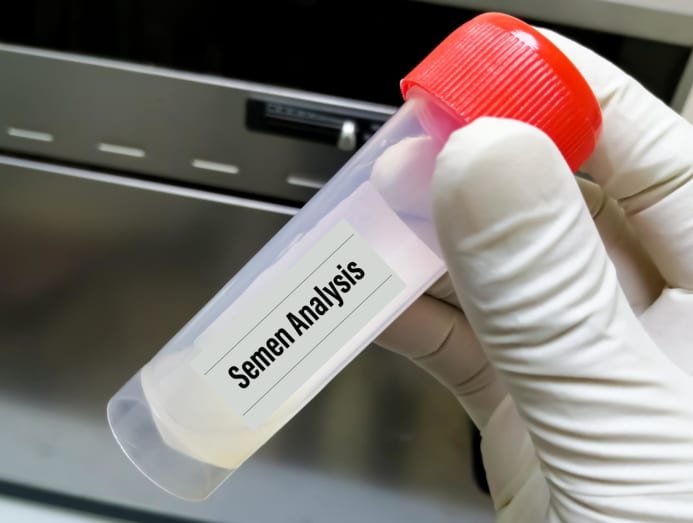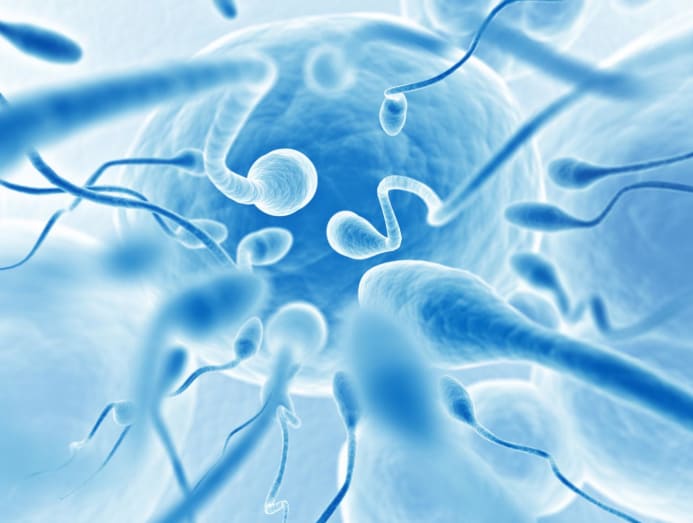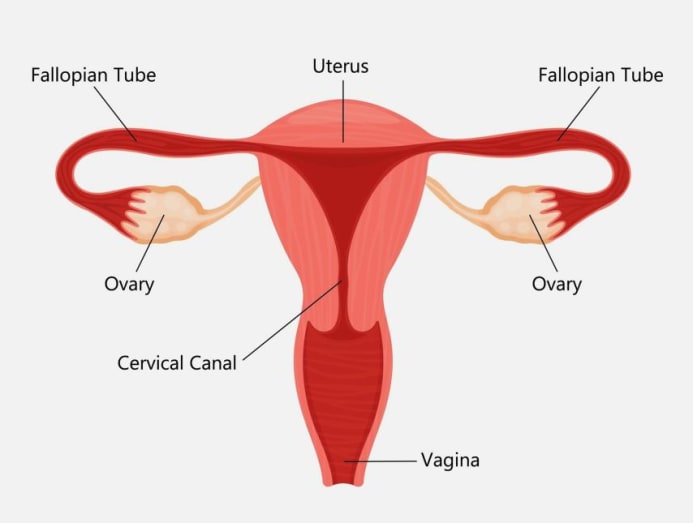What are the signs of male infertility and how to deal with it: Low sperm count, bad swimmers and more
And that’s on top of the treacherous obstacle course that every sperm is put through, starting at the vagina, cervix, uterus and finally, the fallopian tube, where the egg awaits.

(Photo: iStock/courtneyk)
You know the story. Sperm meets egg, they exchange numbers (23 male and 23 female chromosomes, to be exact) and together, they journey down to the uterus, where they pick out a lovely bit of real estate to start a new life.
Of course, it’s not as serendipitous as a successful blind date. There is work to be done before those events can take place. You and the missus have to get busy underneath the sheets, for one. Then, there’s the issue of infertility.
In fact, infertility is as high as 15 per cent among couples in Singapore. “It is approximately one in every seven couples,” according to Assistant Professor Joe Lee, a senior consultant with National University Hospital’s Department of Urology, and an advisor to twoplus Fertility, the Singapore company behind conception-boosting products for home use.
It’s not just a phenomenon in Singapore. Worldwide, “about 15 per cent of couples are infertile, which is defined as the inability to conceive after 12 months of unprotected intercourse”, said Professor Michael Eisenberg, the director of Stanford University Medical Center’s Male Reproductive Medicine and Surgery.

But lest you think that most of the infertility issues pertain to the female reproductive system, think again. “Up to 50 per cent of infertile couples will have a male factor to explain all or part of the couple's infertility,” said Prof Eisenberg, who is also twoplus Fertility's advisor. Locally, in 40 per cent of these male infertility-related cases, the issue lies with the sperm, added Asst Prof Lee.
So while the missus is doing all she can to improve baby-making success such as tracking her ovulation cycle like a hawk, minding her diet and giving up her favourite glass of wine, the other half can also pull their weight by learning about their fertility. Here’s what men need to know:
WHAT ARE THE SIGNS THAT ONE MAY HAVE MALE INFERTILITY?
The problem with male infertility is that it is often undiagnosed until after marriage, said Asst Prof Lee. “Most men with low sperm count do not experience any symptoms and only realise the problem when they undergo semen analysis.”
However, some men may experience symptoms of male infertility, he said, including a poor libido, weak erections or abnormal ejaculations. “Some men may notice they have small testicles or poor development of adult male characteristics such as facial hair.”
In other individuals with male infertility, they may present with varicoceles or dilated veins in the scrotum, said Prof Eisenberg. The job of these veins is to transport oxygen-depleted blood from the testicles.
But when this function is compromised, blood pools in the veins instead, leading to a varicocele that can contribute to the poor development of the affected testicle or low sperm production.
HOW DO YOU DEFINE SPERM QUALITY?
The definitive way to assess if you have male infertility is to undergo a semen analysis at the doctor’s, where the number of sperm, shape of sperm, and movement of sperm are assessed.
Unfortunately, such parameters have been on the decline over the years, according to Dr Lim Min Yu, the president of Obstetrical & Gynaecological Society of Singapore. “There is likely to be a trend towards decreasing sperm quality,” he said.
Studies such as this point to “potential causes" such as "increased rates of obesity, poor diet, and exposure to environmental toxins” but “how this decline in sperm counts reflects fertility has yet to be determined”.

What then is considered good sperm quality? Here’s a closer look at each parameter:
Sperm count: The average volume of ejaculate ranges from 1.5ml to 6ml, according to Dr Ronny Tan, a urologist with Mount Elizabeth Hospitals and Parkway East Hospital. “In a healthy male, at least 15 million sperms are seen in 1ml of ejaculate.” A low sperm count, as defined by the World Health Organization, is less than 15 million sperm per millilitre.
Incidentally, a DIY kit for testing sperm concentration is available for use at home. The Sperm OK by Atron kit is said to offer more than 95 per cent accuracy with results ready in minutes.
Sperm shape or morphology: Each sperm consists of a head, midpiece and tail – and all parts play a role in the fertilisation of the egg, said Dr Tan. The midpiece is akin to the sperm’s engine for providing energy for the tail to propel the sperm forward, he explained.
If it’s the first sperm to reach the egg, its head comes into play next. The head does not only contain DNA material to fuse with the egg, it also has an enzyme to break down the outer membrane of the egg and allow the sperm to penetrate and fertilise the egg, said Dr Tan.

A normal sperm has an oval head with a long tail. Sperm with a large, misshapen head or a head that is too small will have difficulty penetrating the egg. A crooked or double tail can also affect the sperm’s ability to swim and reach the egg.
However, having a large percentage of misshapen sperm isn't uncommon, according to the Mayo Clinic website, which noted that only 4 per cent to 10 per cent of the sperm in a semen sample are normal.
“Most male fertility experts agree that the role of sperm morphology in predicting pregnancy is unclear, and that it's a poor predictor of infertility unless nearly 100 per cent of the sperm are abnormal,” said urologist Dr Sevann Helo on the website.

Sperm movement or motility: Sperm movement is generally categorised into two patterns – progressive motility (swimming mostly in a straight line or large circles) and non-progressive motility (swimming in very tight circles).
For the sperm to get through the cervical mucus to reach the egg, it needs to have a progressive motility of at least 25 micrometers a second. Poor sperm motility is when less than 32 per cent of the sperm can move efficiently.
HOW CAN I IMPROVE MY CHANCES?
It is a pretty tough journey for sperms to swim up the vagina, past the cervix, into the uterus and up the fallopian tubes, according to Dr Wendy Teo, an obstetrician and gynaecologist with Wendy Women’s Clinic at Mount Elizabeth Hospital. “Sperms have to overcome thick cervical mucus, and the acidic nature of the vagina as they enter the uterine cavity,” she said.
And it gets tougher as the sperms reach one of the fallopian tubes, where the egg is released. “The tubes are narrower compared to the uterus and as such, that’s another barrier. Finally, there are immune factors in the female reproductive system that sperms have to overcome before fertilisation can happen,” she said.

In fact, only a few hundred sperms will come close to the egg because of these natural barriers in a woman's body. With so many hurdles to overcome, would it make sense to help these swimmers along by way of certain physical manipulations? Here's what the experts say:
- Preventing semen spillage
“There is no scientific basis for this,” said Dr Teo. “Healthy sperms are microscopic and they would have swum up the cervix. The fluid that spills out is usually semen containing sperms that are less mobile or unhealthy.
”If you’re wondering whether using some sort of physical plug might help retain the semen better, nature has got you covered. “We do know that semen that has been ejaculated usually forms a soft gel inside the vagina, which serves to protect the sperm from acids in the vagina as well as providing a platform for sperm to enter the womb,” said Asst Prof Lee.

- Raising your partner’s legs to retain semen in the vagina
The impact of semen loss due to its backflow after sexual intercourse has not been studied extensively in humans, said Asst Prof Lee. However, it doesn’t take long for sperms to enter the uterus – it’s just a matter of minutes, he said.
- Using lubricant during sex
Its use may smoothen the bedroom action but lubricants don’t really hasten sperms’ journey. Instead, if you use a lubricant that isn’t sperm-friendly, you can kill them. Make sure you pick a lubricant that is paraben-free, glycerin-free and has a neutral pH of 7, said Dr Teo.
- Aiming for orgasms to help the vagina get the semen into the uterus
Again, there is no scientific basis that orgasms have that effect, said Dr Teo. However, “orgasms can encourage intercourse and increase your chances of pregnancy”.
- Eating more natural foods
Put down that slice of pepperoni pizza. Junk food and highly processed food, especially processed meat, are sperm killers, according to this study. Instead, the Prudent diet, which consists of chicken, fish, fruit and vegetables, especially lettuce, tomatoes and whole grains, is good for sperm health, said Dr Tan.






